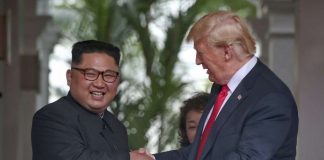APRIL 13, 2019
 Vehicles lining up to enter the United States from Mexico. President Trump has ramped up his messaging against not just illegal immigration but also legal immigration. – Tamir Kalifa for The NY Times
Vehicles lining up to enter the United States from Mexico. President Trump has ramped up his messaging against not just illegal immigration but also legal immigration. – Tamir Kalifa for The NY Times
President Trump last week privately urged Kevin McAleenan, the border enforcement official he was about to name as acting secretary of homeland security, to close the southwestern border to migrants despite having just said publicly that he was delaying a decision on the step for a year, according to three people briefed about the conversation.
It was not clear what Mr. Trump meant by his request or his additional comment to Mr. McAleenan that he would pardon him if he encountered any legal problems as a result of taking the action. Federal judges have already blocked the administration’s attempts to limit asylum seekers who illegally enter the country, and it is not likely that Mr. McAleenan would have ended up in jail if he had followed the president’s directive.
One of the people briefed on the conversation said it was possible Mr. Trump had intended the comments to Mr. McAleenan as a joke. But the conversation, which took place during the president’s visit to the border town of Calexico, Calif., alarmed officials at the Department of Homeland Security who were told of it, according to the people familiar with the remarks.
It was another instance of the president trying to undo a decision and to stretch the boundaries of his power, even when told there were legal issues at stake. The same situation played out on Friday, when Mr. Trump said he was considering releasing asylum seekers into so-called sanctuary cities after administration officials told reporters the proposal was rejected because of legal issues.
The day before his conversation with Mr. McAleenan, Mr. Trump had retreated from his threat to close the border in a matter of days. Instead, he told reporters, he was issuing a “one-year warning” to Mexico to halt illegal immigration and drug trafficking. Privately, however, he was still pushing his aides to halt the flow of asylum seekers across the Mexican border.
Besides Mr. McAleenan, who was then the commissioner of Customs and Border Protection, Mr. Trump was accompanied on the trip by Kirstjen Nielsen, the secretary of homeland security at the time.
 Mr. Trump told Kevin McAleenan, now the acting homeland security secretary, that he would pardon him if he encountered any legal problems as a result of closing the border. – Cedar Attanasio/AP
Mr. Trump told Kevin McAleenan, now the acting homeland security secretary, that he would pardon him if he encountered any legal problems as a result of closing the border. – Cedar Attanasio/AP
Ms. Nielsen had earlier refused to carry through with Mr. Trump’s desire to close the border, telling him it was illegal. But the president encouraged Mr. McAleenan to disregard Ms. Nielsen and enforce the move himself. Two days later, Ms. Nielsen submitted her resignation under pressure from Mr. Trump, and the president appointed Mr. McAleenan to her job on an acting basis.
A White House spokesman declined to respond to requests for comment on the conversation between the president and Mr. McAleenan. Tyler Q. Houlton, a spokesman for the Department of Homeland Security, did not specifically address it.
“At no time has the president indicated, asked, directed or pressured the acting secretary to do anything illegal,” Mr. Houlton said. “Nor would the acting secretary take actions that are not in accordance with our responsibility to enforce the law.”
Mr. Trump’s desire to close the border, despite the legal impediments, was a factor in the forced resignation of Ms. Nielsen. It was one of a number of instances in which Ms. Nielsen believed she was being asked to engage in conduct that violated laws, according to several people with knowledge of those discussions.
The president’s conversation with Mr. McAleenan came at a time when Mr. Trump was considering him as a successor to Ms. Nielsen, whom he was planning to remove from her job, according to officials familiar with his timing. It also came as the factions in the West Wing seeking to oversee immigration policy had been fighting for dominance, creating confusion for the department about whom to deal with or respond to.
The discussion with Mr. McAleenan was one of the most acute examples of Mr. Trump’s desire to use any means to stem the tide of immigrants into the United States, and a reminder of what he would like to see as the unilateral powers of the presidency.
Mr. Trump has been growing increasingly agitated about images of the border he has seen on television, and distressed by the number of immigrants entering the country from the border with Mexico. More undocumented immigrants were apprehended along the southern border in March than in any month since 2007, Customs and Border Protection reported this week.
In response, the president has ramped up his messaging against not just illegal immigration but also legal immigration, mocking asylum seekers as fakes who are pretending to face difficult conditions to ease their passage across the border.
While Mr. Trump has not publicly revisited closing the border, he has repeatedly excoriated Democrats over immigration policy and suggested that he will take more aggressive steps at the border.
“I’m going to have to call up more military,” Mr. Trump told reporters during a visit to San Antonio this week. “Our military, don’t forget, can’t act like they would normally act because if they got a little rough, everybody would go crazy.”
Mr. Trump’s insistence that he was still considering placing undocumented immigrants in sanctuary cities “due to the fact that Democrats are unwilling to change our very dangerous immigration laws” came in a tweet on Friday morning. That statement directly contradicted his own aides, who on Thursday had described the proposal as a “suggestion that was floated and rejected, which ended any further discussion.”
But Mr. Trump was eager to continue the discussion. If Democrats did not agree to new immigration policies, Mr. Trump told reporters at the White House on Friday, “we might as well do what they always say they want.”
“We’ll bring them to sanctuary city areas and let that particular area take care of it,” Mr. Trump continued, adding that California welcomed the idea of more people coming to the state.
“We can give them a lot. We can give them an unlimited supply,” he said.
After Mr. Trump’s comments, a White House spokesman indicated that the proposal was now back on the table, and that Democrats should work with the administration to welcome migrants into their districts.
“Democrats say we must have open borders and that illegal immigrants have a right to be in this country at all costs,” the spokesman, Hogan Gidley said, “so they should be working with the administration to find the best ways to transport those illegal aliens that are already set for release, into communities in their districts and states.”
Democratic lawmakers, however, are not advocating “open borders,” as the president has suggested. They favor enhancing border security, but do not support many of Mr. Trump’s hard-line immigration policy proposals, such as building a wall along the southern border.
Last year, Trump administration officials had floated the idea of transporting migrants to sanctuary cities, which limit how local law enforcement can cooperate with federal immigration officers, as a way to address the influx of migrants crossing the border.
One of the highest-profile sanctuary cities is San Francisco, home to Speaker Nancy Pelosi, one of the most effective opponents of the president’s efforts to change American immigration laws. The White House raised the proposal again in February, seeing it as a way to punish Democrats for their opposition.
Ms. Pelosi’s office condemned the plan.
“The extent of this administration’s cynicism and cruelty cannot be overstated,” said Ashley Etienne, a spokeswoman for Ms. Pelosi. “Using human beings — including little children — as pawns in their warped game to perpetuate fear and demonize immigrants is despicable, and in some cases, criminal.”
Courtesy/Source: NY Times










































































































